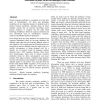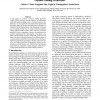119 search results - page 15 / 24 » Weave amino acid sequences for protein secondary structure p... |
JCB
2007
13 years 7 months ago
2007
In our recent work, a new approach to establish sequence relatedness, by walking through the protein sequence space, was introduced. The sequence space is built from 20 amino acid...
BMCBI
2006
13 years 7 months ago
2006
Background: When accurate models for the divergent evolution of protein sequences are integrated with complementary biological information, such as folded protein structures, anal...
APBC
2004
13 years 9 months ago
2004
Protein structure prediction is considered to be the holy grail of bioinformatics. Ab initio and homology modelling are two important groups of methods used in protein structure p...
FLAIRS
2008
13 years 9 months ago
2008
1 In this paper, we propose a peptide folding prediction method which discovers contrast patterns to differentiate and predict peptide folding classes. A contrast pattern is defin...
ICML
2005
IEEE
14 years 8 months ago
2005
IEEE
We develop a novel multi-class classification method based on output codes for the problem of classifying a sequence of amino acids into one of many known protein structural class...


